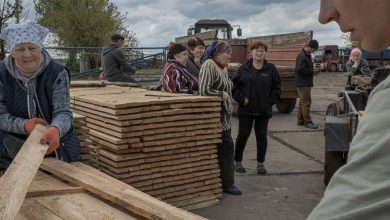A Town on Ukraine’s Edge, Determined to Escape Its Past

PRZEMYSL, Poland — Since the war broke out in Ukraine, the elegant little city of Przemysl, less than 10 miles from the Polish-Ukrainian border, has been transformed into a massive aid machine.
Restaurants are feeding refugees instead of regular customers. School gyms are hosting Ukrainians instead of football games. The local newspaper is raising money for psychological support for Ukrainian and Polish children traumatized by the war.
This town has considered just about every possible need of those fleeing Russian bombs — even taking in their pets.
“We have to help,” said Radek Fedaczynski, a local veterinarian who has been working day and night to spirit out as many Ukrainian dogs and cats as he can (and a stork and baby goat). “It’s our destiny.”
This generous attitude might seem surprising, given Przemysl’s complicated and violent history. This part of Poland endured horrible bloodletting throughout the 20th century, including at the hands of Ukrainian nationalists.

Refugess from the war in Ukraine at a train station in Przemysl, last week.
But after Russia’s invasion of Ukraine, this town seems to have made an instinctive and collective decision to put the bad blood behind it. Like much of Poland itself, Przemysl (pronounced PSHEH-mihsh-ul)) sees the fight in Ukraine almost as its own fight, and it has welcomed the Ukrainian refugees with an outpouring of support, marking a poignant reset in the long and complex Polish-Ukrainian relationship.
During World War II, which is now on the minds of many of Przemysl’s 60,000 residents, Nazis and Soviets took turns invading the city, wiping out civilians. Przemysl’s Jewish community, once a third of the population, was reduced to a few families. As the war was finally ending, bloodshed exploded between Ukrainians and Poles, with Ukrainian nationalists massacring Poles in large numbers and Poles striking back in revenge.
Przemysl has once again put on its war paint. Its trains are taking Ukrainian fighters into the conflict; its bridges are carrying weapons and material to the front; and foreign troops are stomping down its charming, windy, cobbled streets. But this time they are Americans, part of the NATO force based in Poland.
The biggest focus has been helping the 500,000 Ukrainian refugees who have passed through the town, mostly women and children, said the mayor, Wojciech Bakun.
Mr. Bakun co-founded a nationalist political party that had been accused of spreading anti-Ukrainian views before Russia’s invasion. But he has exchanged his business suit for a khaki military jacket and his office in a 16th-century yellow townhouse for the town’s train station, a major refugee transit point, to lead the growing aid efforts.
“I’m not going to explain history to a three-year old who just crossed the border,” he said about his change of attitude.
Many residents said the same thing: Times have changed, and with more than a million Ukrainian workers already in Poland before Russia’s invasion, that sense of otherness between Ukrainians and Poles has gradually worn down.
The aid efforts are having a therapeutic value as well. Helping others, several residents said, has helped take their minds off the war.
A good chunk of the population, especially older residents, are preoccupied with the idea that the Russians might storm across the border. Each time the Russians bomb deeper into western Ukraine, sometimes just a few miles from Polish territory, this fear grows.
“Anything is possible,” said Jan Jarosz, the head of the National Museum of Przemysl.
As he gazed out of his office windows, which look over the town and the San River, he said: “If I were Putin, I’d bomb those two bridges. Everything goes through those bridges.”
He was referring to Przemysl’s main railway bridge (which many fighters going back into Ukraine have used) and a highway bridge across the San River that serves as one of the busiest conduits of supplies and matériel into western Ukraine.
Under a secret pact during World War II, Nazis and Soviets divided Poland, and Przemysl, between themselves. The San River that snakes through town was the border. It separated the Nazi-occupied part, where the Jews were put in a ghetto, from the eastern side of town, which was incorporated into the Soviet Union as part of the Ukrainian Soviet Socialist Republic, where all signs of Polishness were brutally repressed.
Divided families stood on opposite river banks and shouted news to each other. All around them, Russian and German troops hunkered down, sometimes in old fortifications built by generations of invaders to control this area.
Today the new soldiers in town are from the 82nd Airborne Division. The other evening, a busload of Americans, dressed in camouflage and combat boots, marched up to Przemysl’s most popular doughnut shop, which serves hunky oblong pastries (without a hole) stuffed with Nutella or rose jam. The United States has doubled the number of troops it usually stations in Poland, a member of the NATO alliance, to roughly 9,000. When asked what they were doing here, one soldier responded, “To assure and deter.”
Despite all the conflict it has weathered, Przemysl is still a beautiful little city with a 13th- century fortified castle, ornamented Baroque churches, bumpy stone streets and antique charm at every turn. The town even plays a centuries-old bugle call three times a day from its clock tower to mark time passing by.
For centuries, Ukrainians have played an important role in shaping the city’s multicultural heritage. A sizable community of ethnic Ukrainians, has lived here for decades and numbers around 2,000 today. Relations between them and ethnic Poles have steadily improved. But when there’s trouble in Ukraine, trouble can bubble up here, too.
A few years ago, not long after Russia invaded the Crimean Peninsula and wrested it away from Ukraine, nationalists in Przemysl attacked a Ukrainian church procession. The police quickly arrested the culprits. But ethnic Ukrainians suspected that some of Przemysl’s municipal officials had stoked the thugs and that Russia was using Facebook and other social media to sow hatred between Poles and ethnic Ukrainians.
Russia-Ukraine War: Key Developments
Russia’s shrinking force. The Pentagon said that Russia’s “combat power” in Ukraine has dipped below 90 percent of its original force. The assessment reflects the significant losses that Russian troops have suffered at the hands of Ukrainian soldiers.
On the ground. Amid Russia’s stalled invasion, Ukrainians continued to mount a spirited defense of Kyiv and said they had recaptured Makariv, a town about 40 miles away from the capital. In Kherson, videos and photographs showed Russian soldiers opening fire on protesters.
Cracking down on dissent. A Russian court sentenced the opposition leader Aleksei A. Navalny, already serving a two-and-a-half-year prison term for violating parole, to an additional nine years on fraud charges. Russia also amended a draconian censorship law to expand the scope of government bodies off-limits to criticism.
Biden’s diplomatic push. President Biden will press allies for even more aggressive economic sanctions against Russia during a series of global summits in Europe this week, seeking to maintain unity of purpose as Russian forces continue to rain destruction on cities in Ukraine.
“As long as Russia and Ukraine are at war, Russia will keep doing this,” said Kasia Komar-Macynska, a young ethnic Ukrainian community leader.
For Dr. Fedaczynski, the veterinarian, and his four-legged patients, little of this matters. His center, the ADA Animal Hospital, is the closest animal hospital to the border, and the first logical stop for any living thing needing shelter from the war.
Nearly every day he sends a pet rescue squad into Ukraine or receives a truckload of anxious animals coming out of the war.
His hospital has been coordinating closely with animal shelters in Ukraine to rescue animals from large shelters, private houses and nearly deserted apartment blocs, even military airports. Some Ukrainian pet owners have sent their animals out of besieged cities while they themselves remain behind, with the hope that they will be reunited one better day.
After the animals arrive at Dr. Fedaczynski’s clinic, his staff examines, vaccinates and puts chips in them. They have rescued more than 600 so far — Chihuahuas, German shepherds, one Egyptian cat, hundreds of other cats, a mutt named Rocky Balboa, the stork with a broken beak and a 10-day-old goat named Sasha.
The animals are often too traumatized to move. To ease their suffering, the hospital staff takes them for walks, lets the dogs romp around together on special playgrounds and plays classical music to a room full of caged cats so they can fall asleep more easily.
Dr. Fedaczynski said it really helped the Ukrainians who stayed in their war-torn country to know that their pets were safe. But it helps him too.
When the war erupted in Ukraine, he said, it was like “the worst dreams came true.”
“When you think about it, you can go crazy, so you need to do something,” he explained. “It makes you feel good.”
Erin Schaff contributed reporting.




